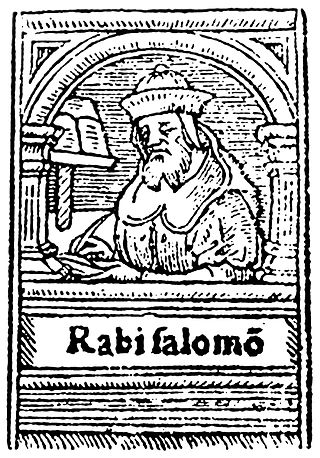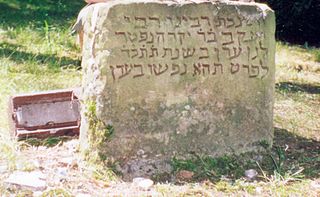Related Research Articles

Shlomo Yitzchaki, generally known by the acronym Rashi, was a medieval French rabbi, the author of comprehensive commentaries on the Talmud and Hebrew Bible.

The Talmud is the central text of Rabbinic Judaism and the primary source of Jewish religious law (halakha) and Jewish theology. Until the advent of modernity, in nearly all Jewish communities, the Talmud was the centerpiece of Jewish cultural life and was foundational to "all Jewish thought and aspirations", serving also as "the guide for the daily life" of Jews.

The Tosafot,Tosafos or Tosfot are medieval commentaries on the Talmud. They take the form of critical and explanatory glosses, printed, in almost all Talmud editions, on the outer margin and opposite Rashi's notes.

Obadiah ben Abraham of Bertinoro, commonly known as "The Bartenura", was a 15th-century Italian rabbi best known for his popular commentary on the Mishnah. In his later years, he rejuvenated the Jewish community of Jerusalem and became recognised as the spiritual leader of the Jews of his generation.
Shemaiah, or Shmaya was a rabbinic sage in the early pre-Mishnaic era who lived at the same time as Abtalion. They are known as one of the zugot ("couples"): Shemaiah and Abtalion; Shemaiah holding the title of nasi, whilst Abtalion holding the office of Av Beit Din.
Menachem ben Solomon Meiri or Hameiri (1249–1315) was a famous Catalan rabbi, Talmudist and Maimonidean.
Samuel ben Meir, after his death known as "Rashbam", a Hebrew acronym for RAbbi SHmuel Ben Meir, was a leading French Tosafist and grandson of Shlomo Yitzhaki, "Rashi".
Moshe haDarshan was chief of the yeshiva of Narbonne, and perhaps the founder of Jewish exegetical studies in France. Along with Rashi, his writings are often cited as the first extant writings in Zarphatic, the Judæo-French language.
Tobiah ben Eliezer was a Talmudist and poet of the 11th century, author of Lekach Tov or Pesikta Zutarta, a midrashic commentary on the Pentateuch and the Five Megillot.
Nathan ben Jehiel of Rome was a Jewish Italian lexicographer. He authored the Arukh, a notable dictionary of Talmudic and Midrashic words, and consequently he himself is often referred to as "the Arukh".
Tamid is the ninth tractate in the Order of Kodashim, which is the fifth of the six orders of the Mishnah, Tosefta and the Talmud. The main subject of Tamid is the morning and evening burnt offerings, but it also deals with other Temple ceremonies. The tractate includes information about the Temple Service from sages who had been present at the Temple and witnessed the service. This tractate in the Talmud contains few disagreements between the sages and few exegetical derivations. It is written as a historical description of the service.

Yaakov ben Yakar was a German Talmudist. He flourished in the first half of the 11th century. He was a pupil of Gershom ben Judah in Mainz, and is especially known as the teacher of Rashi, who characterizes him as Mori HaZaken.
Isaiah di Trani ben Mali (the Elder) (c. 1180 – c. 1250) (Hebrew: ישעיה בן מאלי הזקן דטראני), better known as the RID, was a prominent Italian Talmudist.
Jewish commentaries on the Bible are biblical commentaries of the Hebrew Bible from a Jewish perspective. Translations into Aramaic and English, and some universally accepted Jewish commentaries with notes on their method of approach and also some modern translations into English with notes are listed.

Midrash Samuel is an aggadic midrash on the books of Samuel.
Judah ben Nathan, also referred to by the Hebrew acronym RIBaN, was a gifted French rabbi and commentator on the Talmud in the eleventh to twelfth century, best known for being the son-in-law and pupil of the great commentator Rashi, and to a great extent his continuator.
In rabbinic Jewish eschatology, the Righteous Priest or Priest of Righteousness is a figure identified with one of the Four Craftsmen in a vision mentioned in the Book of Zechariah. He is found in the Talmud and Midrash.
Solomon Sirilio (1485–1554), the son of Joseph Sirilio, was a Spanish rabbi and author of one of the first commentaries written about the Jerusalem Talmud.
Tosafot Hachmei Anglia is a Talmud commentary composed by one of the Tosafists living in England.
References
![]() This article incorporates text from a publication now in the public domain : Wilhelm Bacher; Schulim Ochser (1901–1906). "Shemaiah of Soissons". In Singer, Isidore; et al. (eds.). The Jewish Encyclopedia . New York: Funk & Wagnalls.
This article incorporates text from a publication now in the public domain : Wilhelm Bacher; Schulim Ochser (1901–1906). "Shemaiah of Soissons". In Singer, Isidore; et al. (eds.). The Jewish Encyclopedia . New York: Funk & Wagnalls.